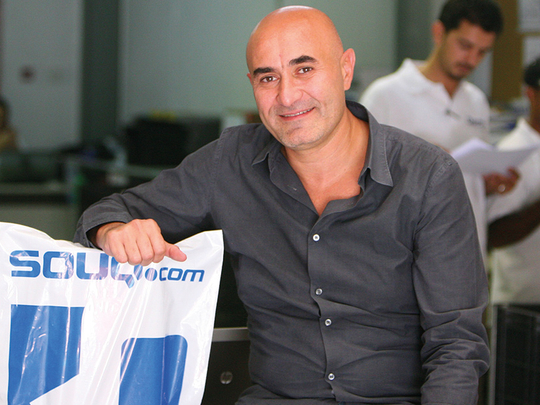
First Amazon, then Emaar Malls — everyone wanted a piece of the 11-year old Souq.com.
Although Amazon finally won, some questioned why a mall operator would want to buy an online retailer. There is a logic, particularly if one looks at highly developed retail markets such as the US.
In recent quarters we’ve seen a significant slowdown in US brick-and-mortar retailers.
Store closures are skyrocketing. Macy’s announced 100 closures; Walmat is closing 269 across 154 locations; Kmart/Sears are shuttering 78 stores and Ralph Lauren 50.
Other retailers have found themselves bankrupt, notably American Apparel, Sporting Authority and Aeropostale. This may not reflect as much about the US economy as it does consumer behaviour.
Traditional retailers are under attack. They’re shutting stores and going out of business. At the same time, consumers are the savviest they’ve ever been; equipped with mobiles they have two weapons — convenience and price discovery.
Consumers visit malls and high-streets to window shop and go home to transact online. The brick-and-mortar store is turning into a showroom — or in business parlance, a loss leader. The cost of being in a great location in a great mall to get customers through the door is high.
Online stores don’t have those same fixed costs. They require less capital, scale much better and have incredible customer analytics capabilities.
Customer reach has also been influenced by technology. Instagram and Snapchat bombard us with luxury goods modelled by social influencers. Netflix entertains us with consumer gadget placements and YouTube amazes us with the inner workings of Tesla’s Gigafactory. S martphones equip us to instantly acquire most of these products with a couple of taps. The retail journey has totally changed.
Everyone wanting to stay in business has opened an online store. Those stores are going to increasingly cannibalise brick-and-mortar operations. The UAE is home to several smart retailers, namely Al Tayer and their two hour delivery promise with Ounass.
The other is Salama Alabbar’s BySymphony that’s being rolled up into Net-A-Porter. A more direct comparable to Souq.com are consumer electronics retailers Sharaf DG and Al-Futtaim’s Plug-ins, both having developed online offerings.
All of these businesses have brick-and-mortar locations. They also know the growth will be coming from browsers and apps. A recent study by PWC claims the percentage of daily online shoppers in the Middle East doubled from 6 per cent in 2014 to 12 per cent in 2015.
Back in the early 2000s many a pundit wrote at length about the demise of brick-and-mortar and how everything was soon to go online. The dotcom crash of 2001 reset a lot of expectations and many online marketplaces shut down (remember Pets.com?). The transition to “online” was going to take longer than we expected, or maybe not.
In 2001 Amazon generated sales of just $2.76 billion from 20 million customers. Fifteen years later, that number is $136 billion from customers in 185 different countries. The e-commerce revolution isn’t coming, it’s happened.
What does this mean for malls? Going back to the US, many of the retailers previously mentioned are regarded as anchor tenants for malls. Their presence usually attracts customers and drives foot-flow.
With anchor tenants scaling back, this leaves many malls with core locations empty. There’s no shortage of malls either. The US has approximately five times as many malls per person than the UK, and double that of Australia.
It’s not a good time to be a US mall owner … a tsunami of vacancies and rent cuts are on the horizon.
Could this happen in the UAE? We certainly feel we have a lot of malls. The raw numbers don’t seem that worrying though. According to the International Council of Shopping Centers, the US has over 15 times more shopping malls per capita than the UAE.
So perhaps there’s no oversupply here to begin with.
I also believe that nature has a huge role to play. The UAE is subject to several months of scorching weather that makes outdoor activities — other than being in water — somewhat uncomfortable. We need the climate control offered by indoor spaces, and when you have lots of people captive indoors, businesses are going to want to sell them stuff.
Perhaps the UAE and the Gulf should naturally have a higher number of malls per capita than the likes of the US just because of this.
But it doesn’t mean consumers are going to necessarily transact in malls littered with physical stores. This could well be the logic behind Emaar Mall’s interest in Souq.com. If true, this is a drastic change in strategy and one that I haven’t seen any large mall operator embark on.
Questions abound. Has Emaar Malls run out of good brick-and-mortar opportunities? Is this a hedge against their concentration in brick-and-mortar? Are there substantial lessons from managing physical retail spaces that can be applied to online?
Is Emaar Malls turning into a retailer itself? What will tenants at Dubai Mall have to say about that?
Although Souq has been sold to Amazon, it’ll be interesting to see if Emaar Malls continues hunting. A strategic decision to move into e-commerce has likely been taken, so don’t rule out the possibility they might acquire smaller rivals.
Either way, it shows that if you’re based in the UAE and start a company that scales, it’s possible to grab the attention of the world’s biggest companies. A wonderful example of “Build it and they will come!”
The writer is a Kuwaiti investor and adviser based in Dubai. He is on Twitter at @alialsalim












